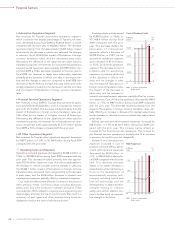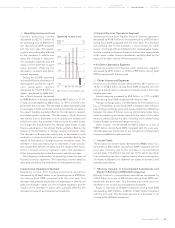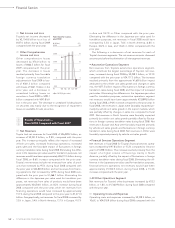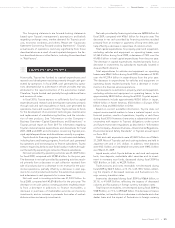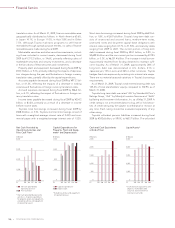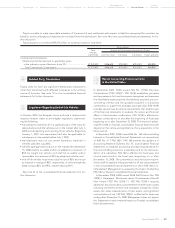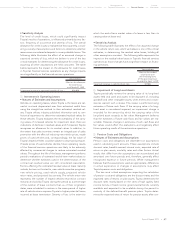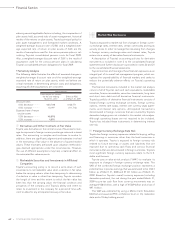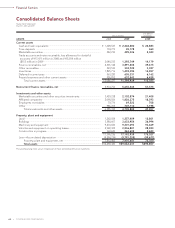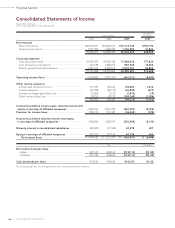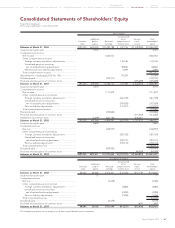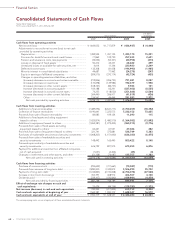Toyota 2009 Annual Report Download - page 62
Download and view the complete annual report
Please find page 62 of the 2009 Toyota annual report below. You can navigate through the pages in the report by either clicking on the pages listed below, or by using the keyword search tool below to find specific information within the annual report.
Financial Section
TOYOTA MOTOR CORPORATION
60
In April 2009, FASB issued FASB Staff Position No. FAS 115-2
and FAS 124-2, Recognition and Presentation of Other-Than-
Temporary Impairments (“FSP FAS 115-2 and FAS 124-2”). FSP
FAS 115-2 and FAS 124-2 revises the recognition and presenta-
tion requirements for other-than-temporary impairments of debt
securities, and contains additional disclosure requirements relat-
ed to debt and equity securities. FSP FAS 115-2 and FAS 124-2
is effective for interim period and fiscal year ending after June
15, 2009. Management does not expect this Statement to have
a material impact on Toyota’s consolidated financial statements.
In May 2009, FASB issued FAS No. 165, Subsequent Events
(“FAS 165”). FAS 165 is intended to establish general standards of
accounting for and disclosure of events that occur after the bal-
ance sheet date but before financial statements are issued. FAS
165 is effective for interim period or fiscal year ending after June
15, 2009. Management does not expect this Statement to have
a material impact on Toyota’s consolidated financial statements.
Critical Accounting Estimates
The consolidated financial statements of Toyota are prepared in
conformity with accounting principles generally accepted in the
United States of America. The preparation of these financial
statements requires the use of estimates, judgments and
assumptions that affect the reported amounts of assets and lia-
bilities at the date of the financial statements and the reported
amounts of revenues and expenses during the periods present-
ed. Toyota believes that of its significant accounting policies,
the following may involve a higher degree of judgments, esti-
mates and assumptions:
Product Warranty
Toyota generally warrants its products against certain manufac-
turing and other defects. Product warranties are provided for
specific periods of time and/or usage of the product and vary
depending upon the nature of the product, the geographic
location of the sale and other factors. All product warranties are
consistent with commercial practices. Toyota includes a provi-
sion for estimated product warranty costs as a component of
cost of sales at the time the related sale is recognized. The
accrued warranty costs represent management’s best estimate
at the time of sale of the total costs that Toyota will incur to
repair or replace product parts that fail while still under warranty.
The amount of accrued estimated warranty costs is primarily
based on historical experience of product failures as well as cur-
rent information on repair costs. The amount of warranty costs
accrued also contains an estimate of warranty claim recoveries
to be received from suppliers. The foregoing evaluations are
inherently uncertain, as they require material estimates and
some products’ warranties extend for several years.
Consequently, actual warranty costs will differ from the estimat-
ed amounts and could require additional warranty provisions. If
these factors require a significant increase in Toyota’s accrued
estimated warranty costs, it would negatively affect future oper-
ating results of the automotive operations.
Allowance for Doubtful Accounts and Credit Losses
• Natures of Estimates and Assumptions
Sales financing and finance lease receivables consist of retail
installment sales contracts secured by passenger cars and com-
mercial vehicles. Collectibility risks include consumer and dealer
insolvencies and insufficient collateral values (less costs to sell)
to realize the full carrying values of these receivables. As a mat-
ter of policy, Toyota maintains an allowance for doubtful
accounts and credit losses representing management’s estimate
of the amount of asset impairment in the portfolios of finance,
trade and other receivables. Toyota determines the allowance
for doubtful accounts and credit losses based on a systematic,
ongoing review and evaluation performed as part of the credit-
risk evaluation process, historical loss experience, the size and
composition of the portfolios, current economic events and con-
ditions, the estimated fair value, adequacy of collateral and
other pertinent factors. This evaluation is inherently judgmental
and requires material estimates, including the amounts and tim-
ing of future cash flows expected to be received, which may be
susceptible to significant change. Although management con-
siders the allowance for doubtful accounts and credit losses to
be adequate based on information currently available, addition-
al provisions may be necessary due to (i) changes in manage-
ment estimates and assumptions about asset impairments, (ii)
information that indicates changes in expected future cash
flows, or (iii) changes in economic and other events and condi-
tions. To the extent that sales incentives remain an integral part
of sales promotion with the effect of reducing new vehicle pric-
es, resale prices of used vehicles and, correspondingly, the col-
lateral value of Toyota’s sales financing and finance lease
receivables could experience further downward pressure. If
these factors require a significant increase in Toyota’s allowance
for doubtful accounts and credit losses, it could negatively affect
future operating results of the financial services operations. The
level of credit losses, which has a greater impact on Toyota’s
results of operations, is influenced primarily by two factors: fre-
quency of occurrence and severity of loss. For evaluation pur-
poses, exposures to credit loss are segmented into the two
primary categories of “consumer” and “dealer”. Toyota’s con-
sumer portfolio consists of smaller balances that are homoge-
nous retail finance receivables and lease earning assets. The
dealer portfolio consists of wholesale and other dealer financing
receivables. The overall allowance for credit losses is evaluated
at least quarterly, considering a variety of assumptions and fac-
tors to determine whether reserves are considered adequate to
cover probable losses.


